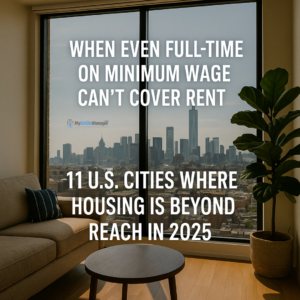In theory, a full-time job should provide enough income to cover the basics: food, utilities, transportation, and most importantly housing. Yet in 2025, the numbers tell a very different story. Across the United States, minimum-wage workers are being priced out of major cities, forced to choose between rent and other essentials.
A new analysis shows that in 11 of the nation’s largest cities, even working 40 hours a week at minimum wage is not enough to afford a modest one-bedroom apartment. The gap between income and housing costs has widened so much that in some places, rent can eat up more than an entire paycheck.
The Most Unaffordable Cities
The data highlights just how extreme the housing burden has become. Here are the 11 cities where minimum-wage workers are most heavily impacted:
| City | Estimated Monthly Income (Min. Wage) | Rent as % of Income |
|---|---|---|
| Atlanta, GA | ~$1,160 | 107.76% |
| Miami, FL | ~$2,240 | 89.29% |
| San Francisco, CA | ~$2,987 | 88.71% |
| Houston, TX | ~$1,160 | 86.21% |
| Dallas, TX | ~$1,160 | 86.21% |
| San Diego, CA | ~$2,760 | 74.28% |
| Los Angeles, CA | ~$2,765 | 60.66% |
| Orlando, FL | ~$2,240 | 57.81% |
| Chicago, IL | ~$2,592 | 49.07% |
| Phoenix, AZ | ~$2,352 | 46.22% |
| New York, NY | ~$2,640 | 37.88% |
Atlanta sits at the top of the list for least affordability. With a monthly minimum wage income of just over $1,100, the average rent in the city exceeds that amount. In other words, a worker could hand over every single paycheck and still fall short.
Miami, San Francisco, and Houston aren’t far behind, with rent consuming between 86% and 89% of monthly wages. Even in New York City, which ranks the “most affordable” among the 11, the average rent still takes nearly 40% of a minimum-wage earner’s income well above the recommended 30% threshold.
Why This Matters: The 30% Rule
Housing experts have long advised that households should spend no more than 30% of their income on rent. Crossing that line often leads to “rent burden,” leaving little room for food, transportation, healthcare, savings, or emergencies.
For many minimum-wage workers, however, the numbers don’t add up. In the cities listed above, rent alone consumes half or in some cases more than all of a paycheck. This forces households into impossible choices: piling up credit card debt, working multiple jobs, or living in overcrowded housing.
Broader Economic Pressures
The affordability crisis is not just about wages. Other financial pressures compound the issue:
-
Rising rents: Nationwide, rents have surged by about 24% since March 2021, according to housing studies.
-
Ballooning debt: At the same time, U.S. credit card debt has jumped more than 50%, as families rely on credit to cover daily costs.
-
Inflation squeeze: Everyday essentials groceries, gas, utilities have grown significantly more expensive, leaving households with less flexibility.
The end result? Even with full-time employment, many Americans simply cannot make ends meet.
The Bigger Picture: What’s Needed
The National Low Income Housing Coalition (NLIHC) reports that in 2025, a full-time worker must earn at least $28.17 per hour to afford a modest one-bedroom apartment. For a two-bedroom, the wage requirement jumps to $33.63 per hour. Compare this to the federal minimum wage of $7.25 per hour unchanged since 2009 and the gap becomes painfully clear.
This means there is no U.S. state, metro area, or county where a minimum-wage earner can afford housing without being rent-burdened. Solutions being debated include:
-
Raising minimum wages to reflect modern housing costs.
-
Expanding affordable housing programs in high-demand cities.
-
Implementing rent control measures to stabilize costs.
-
Increasing housing supply by removing zoning and regulatory barriers to new construction.
Without systemic change, the housing crisis will continue to push low-wage workers out of major urban centers often into longer commutes, unstable housing, or homelessness.
Final Thoughts
The American dream has always been built on the idea that hard work provides stability. But for millions of workers in 2025, even a full-time job at minimum wage is no guarantee of a roof over their head.
The affordability crisis in these 11 cities is not just a statistic it represents families doubling up in small apartments, workers sacrificing meals to make rent, and young people postponing independence. Until wages, housing policies, and affordability catch up with reality, the gap between income and rent will remain one of the most pressing challenges for America’s cities.
Source: AS USA These 10 big cities are too expensive for anyone earning minimum wage to afford rent in 2025 (Read the full article here)

